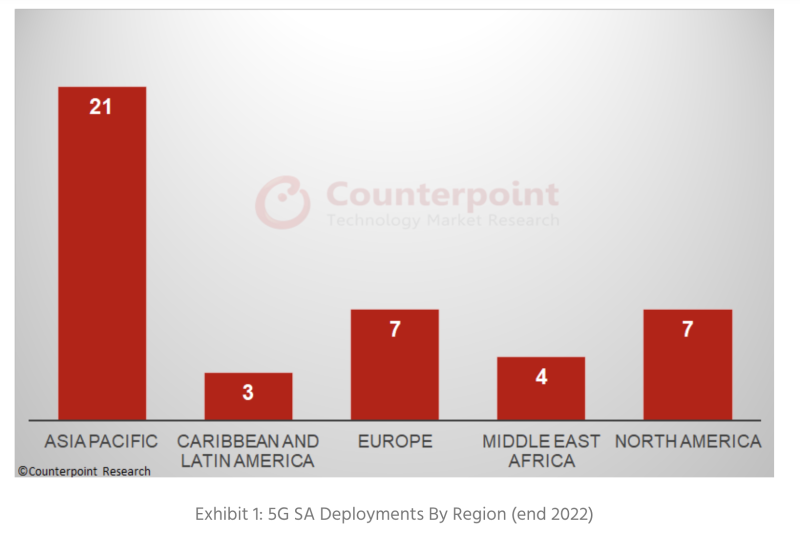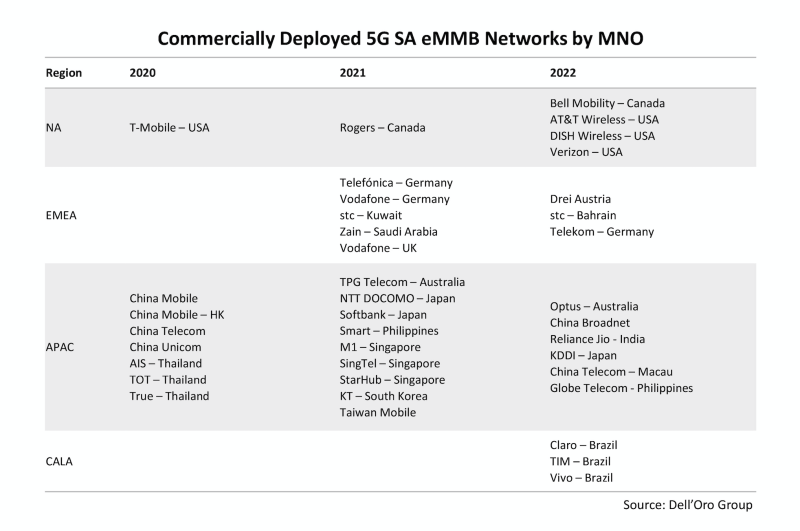5G standalone (SA) networks are now deployed in the majority of major operators around the world. 5G SA means that operators are not only running 5G in their radio access networks (RAN), but they have also converted their 4G cores to 5G.
Recently, Dell’Oro published a blog, naming all the known 5G SA networks, which include all the majors in North America, as well as important operators in Europe, such as Vodafone and Telefonica, along with an extensive list of operators in China, Japan and India. (See the list at the bottom of this story).
But 2023 is likely to be a big year for a lot of smaller operators around the globe to implement 5G SA cores.
Counterpoint Research recently put out a new report, which came up with similar findings as Dell’Oro — that the Asia-Pacific region led the world in 5G SA at the end of 2022, followed by North America and Europe, with the other regions – Middle East and Africa and Latin America – lagging behind.
The analysts said that by the end of 2022, 5G coverage had reached about 1 billion subscribers worldwide. Although most of the 5G deployments in 2022 were in the developed economies of the world, Counterpoint expects the bulk of 5G network rollouts in 2023 will be in emerging markets. This will drive the continuing transition from 5G non-standalone to 5G SA.

According to Counterpoint, 42 operators have deployed 5G SA commercially with many more testing and in trials. “In some markets, operators have adopted a ‘wait-and-see’ approach and are looking for evidence of successful use cases before switching from 5G NSA to SA,” they said.
Vendors
Ericsson and Nokia lead the 5G SA core market globally and are benefiting from the geopolitical sanctions on Chinese vendors Huawei and ZTE in some markets, wrote Counterpoint. The Asian vendors Samsung and NEC are mainly focused on their respective domestic markets but are expanding their reach to Tier-2 operators and emerging markets, while U.S. vendor Mavenir is active across all regions, with multiple deployments due to become live in 2023, including several with Tier-1 operators.
On its recent Q4 2022 earnings, Nokia CEO Pekka Lundmark was asked about 5G SA core. Lundmark said, “Obviously 5G standalone is now the name of the game because you need 5G standalone in terms of getting the full benefits of 5G. There is going to be a lot of investment in 5G core, and operators will be implementing some critical important services like slicing, which require investment in the 5G core."
He said Nokia’s core network software is “highly profitable, and it is something we are investing significant amounts of money in.”
Nokia is in the process of making its core network software cloud-native, and it’s also started offering it as-a-service.
Here's Dell'Oro's list of operators that have implemented 5G SA cores.

